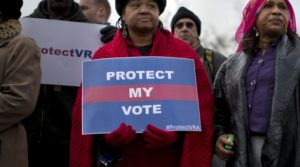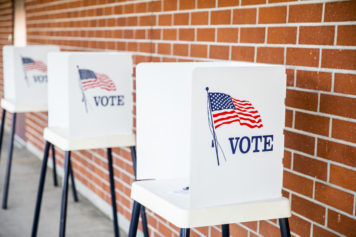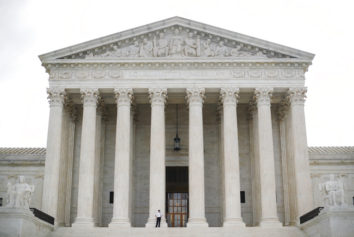
People wait in line outside the Supreme Court in Washington, Wednesday, Feb. 27, 2013, to listen to oral arguments in the Shelby County, Ala., v. Holder voting rights case. (Evan Vucci/AP)
With the recent death of Supreme Court Justice Antonin Scalia, the conservative stronghold on the high court has ended, and now President Obama has an opportunity to shape the institution with another nominee. The next Supreme Court justice will have a crucial role in deciding the legal issues facing the U.S. However, Republican leadership in the Senate has vowed to block any nominee who comes their way. Many critical issues hang in the balance, not the least of which is voting rights and equal access to the ballot box.
Across the country, Republican-controlled state houses — going for broke and relying on a dwindling white conservative electorate for their votes — are blocking the votes of people of color and those who do not fit into their demographic. In 2013, the Supreme Court gutted the Voting Rights Act with the Shelby County v. Holder decision, and Republicans in Congress have not restored it. And since 2012, 16 states have passed voting restrictions such as voter ID, including a number of Southern states that were required under the Voting Rights Act to seek approval from the federal government before making any changes to their voting systems. These voting restrictions have a disproportionate impact on people of color, women, the elderly, the young and others.
It is with that backdrop that the case of Evenwel v. Abbott is under consideration by the Supreme Court. The case, dealing with the concept of one-person, one-vote, has the potential to change the way that states draw legislative districts. While the maps typically are crafted by dividing the districts into roughly equal populations, a new system promoted by the plaintiffs in the case would draw the maps based on the number of potential voters, which would exclude non-citizen immigrants, disenfranchised felons and people under 18 who are not old enough to vote.
This past week, Democrats fought back with a new campaign called #FillThe Seat, which challenges Republican obstruction to the vote for a Supreme Court nominee. Last Thursday, the DNC held a press call with DNC Chair, Rep. Debbie Wasserman Schultz (D-FL); Rep. G. K. Butterfield (D-NC), Chairman of the Congressional Black Caucus; and Rep. Judy Chu (D-CA), Chairwoman of the Congressional Asian Pacific American Caucus (CAPAC).
“The next Supreme Court justice will play a pivotal role in determining whether our nation continues to build upon its long march toward an inclusive democracy, or whether our democracy is further weakened by cynical political ploys that decrease voter participation,” Wasserman Schultz said.
The DNC chair noted the Supreme Court is faced with a number of important questions that get to the heart of American democracy.
“Who can vote? Do we stand behind the principle of one person, one vote? What burdens are too great to place on people exercising their right to vote?” she added. “How can Congress and the law best protect voters from systemic challenges to voting? Whether politicians should pick their voters, or if voters should pick their politicians?”
Wasserman Schultz made the case that such questions need answers, which is why Republicans should not be allowed to stall on the president’s nominee the until after the election. She argued that while the GOP says “the people” should decide the future direction of the court, the people spoke loudly when they elected President Obama in 2008 and again in 2012.
“The Republican Party’s resistance does not rest in the Constitution – it lies with their own self-interest. This is a page they’ve recycled from their playbook: If you don’t like the election results, try to change the rules,” Wasserman Schultz added, promoting the notion that Republicans believe they win when fewer people vote.
In addition, the Florida congresswoman addressed the Republican presidential candidates who have blocked efforts to increase access to the ballot box. For example, Ted Cruz supported discriminatory Texas voter ID laws, and Marco Rubio has opposed early voting in his home state of Florida. And Ohio Gov. John Kasich eliminated same-day registration in his state.
“After all of his race-baiting and demagoguery, could you imagine what a Donald Trump-appointed justice would think about guaranteeing equal access to the ballot?” Wasserman Schultz asked.
Chairman Butterfield of the CBC provided an overview of what is at stake with the high court’s elimination of a key provision in the Voting Rights Act that blocked the implementation of discriminatory voting laws. According to Butterfield, the provision was one of the most effective tools to eradicate voting rights discrimination.
“Without question, the Voting Rights Act is widely regarded as one of the most successful and impactful pieces of civil rights legislation in our nation’s history,” the CBC chair said.
Despite the gains made since 1965 when the law was enacted, challenges to voting have remained, such as the purging of Black Florida voters in the 2000 election, and the four-hour long lines in Virginia in the 2012 election.
And since the gutting of the Voting Rights Act, Butterfield noted, the Republican-controlled state legislature in North Carolina enacted one of the most draconian election laws in America. The legislation eliminated same-day registration, cut early voting, and added a restrictive photo ID requirement. Further, the law eliminated pre-registration and the ability for someone to vote closest to home or their children’s school. Across the nation, more than 20 GOP-controlled states have followed suit since the 2010 election.
“We as a nation have worked too hard to protect and expand the right – over 146 years since the ratification of the 15th Amendment – for us to turn back now. We need President Obama to fill the seat to ensure that the franchise is protected for generations to come,” Butterfield urged.
“This is just the latest sign of disrespect from a Republican party that has treated this president with hostility from the moment he took the oath of office,” the Black Caucus chair said of Republican obstruction, noting other examples of disrespect shown to Obama. For example, during a joint session of Congress in the President’s first year in office, Rep. Joe Wilson (R-SC) interrupted Obama by shouting “You lie!” Butterfield argued that it is time for the Republicans to show Obama some respect and allow him to fulfill his constitutional duty.
Finally, Chairwoman Chu of the CAPAC commented on the Evenwel case in the Supreme Court. The case could force states to leave out large segments of their population — non-voters such as legal permanent residents and minors under 18 — when new state legislative districts are drawn.
“Everyone should be counted in our democracy, and that’s why the Constitution requires it when drawing congressional districts. State legislative districts should not be any different,” Chu said. Further, communities of color would be left underrepresented and uncounted, including 30 percent of Black people, one-third of Native Americans, 45 percent of Asian Americans, and 55 percent of Latinos.
“A full 22 percent of the United States population is both native-born and under the age of 18. That’s over 70 million young Americans who would be left unrepresented,” Rep. Chu added, also providing some context on what would happen in her own state.
“This case is more than simply legislative lines. It is a question of who counts in our democracy,” the congresswoman said. “In my home state of California, nearly 40 percent of the population would be rendered invisible if the Texas conservatives have their way. And we all know that if residents – children – are invisible when drawing legislative districts, they may be invisible when considering funding for schools, healthcare, roads and other infrastructure.”


